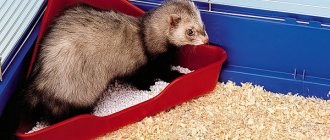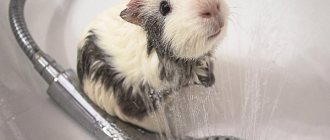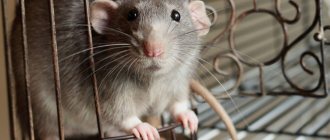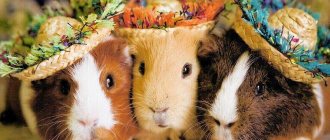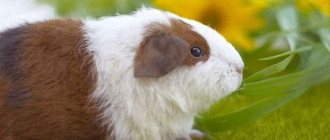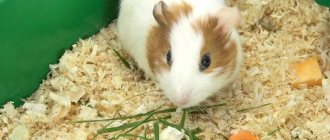Funny, peaceful guinea pigs are popular among pet lovers. These animals live in cages, do not cause much trouble, and give a lot of positive emotions. But there is one drawback to keeping these animals. Even with regular cleaning of the cage, an unpleasant odor from your pet's excrement appears. The problem can be eliminated by properly arranging a toilet for the animal, which is easy to clean and maintain order in the cage. However, it should be taken into account that the process of accustoming an animal to a tray is quite complex and will require a lot of patience. There are certain rules and techniques that allow you to instill such a useful skill in a rodent.
How to train a guinea pig to the toilet (tray) in one place
Everyone knows that guinea pig urine has a strong, pungent and unpleasant odor. Often this feature is the reason why many people give up the idea of owning an animal. If your guinea pig is not accustomed to peeing in the same place, you will have to clean the cage daily and change all the bedding.
But many people do not know that there is a very simple way to avoid these problems - you need to train the animal to go to the toilet in a special container, and all problems associated with odor will be solved.
Guinea pig litter boxes come in a variety of sizes and designs. All of them are in the form of containers with a removable lid and an entrance hole that allows the guinea pig to easily get inside. The shape of the toilet can be square, rectangular, triangular. If you buy a toilet at a pet store, then the kit will also include a small bag with a special filler and a scoop for filling and subsequent cleaning.
You need to choose a filler that will absorb moisture and odor well. You can use sawdust as a filler, but since it does not dry well, you will have to clean the toilet every day. It is necessary to remember that sawdust is a natural material and your pet will really like it, and you can clean the toilet very quickly.
Article on the topic: Guinea pig: care and maintenance at home for beginners
If sawdust is used as bedding in the cage, it must be changed daily. In extreme cases, cleaning should be done every other day.
You can use ordinary river sand, but it must first be washed, dried and calcined so that no infection gets into the guinea pig's cage with it.
Fillers sold in pet stores have different structures and are made from a variety of raw materials. Lump litter can be made from clay, wheat, or the core of a corn cob. Each of the materials has both advantages and disadvantages.
Clay litter is convenient because it is easy to clean, and you don’t have to immediately replace the entire contents of the toilet, but only remove dirty lumps. However, this filler contains quartz dust, which can have a negative impact on the health of the animal, so not all owners are willing to purchase it for their pets.
Other clumpy litters are made from grain waste or corn cob cores. They are absolutely not dangerous for the animal, but there are cases when guinea pigs, instead of using them for their intended purpose, begin to eat it. If you notice that your pet eats litter over and over again, you need to start using a different type of litter. Even if it is harmless to health, guinea pigs should not eat it instead of food.
In addition to fillers with a lumpy structure, there are also granular fillers. They are made from waste from the flour milling and woodworking industries, as well as from environmentally friendly meadow grasses and paper. Such fillers absorb moisture well and will not need to be changed so often. But there are also disadvantages: granular fillers cannot be partially replaced, like their counterparts with a lumpy structure. You will have to completely throw away all the contents of the toilet, thoroughly wash the container, wipe it dry and add a new portion of the litter.
Article on the topic: Names for guinea pigs for boys and girls, how to choose the right nickname
It is not at all necessary to buy a toilet in pet stores; you can make it for your pet yourself. To do this, you will need a plastic container of a suitable size with a lid. On one side, it is necessary to cut a hole of such a size that the animal can easily get inside. It should be raised 1.5–2.5 cm above the base of the container so that the guinea pig does not scatter the filler. The height of the threshold depends on the size of the animal itself. The diameter of the entrance also depends on the size of the guinea pig. The edges of the hole must be thoroughly sanded so that they are smooth.
But the toilet does not have to be made of plastic materials; it can be made of glass. Such a toilet has a number of advantages: you don’t need special skills to make it, you don’t have to go to a pet store, it will last a long time, since a guinea pig won’t be able to gnaw it, and glass doesn’t absorb the smell. You just need to choose a container of the appropriate size with a wide neck so that the animal can fit into it comfortably. The container must be secured so that the guinea pig does not knock it over and it does not roll on the floor of the animal’s home.
Choosing a place for the toilet
To toilet train your guinea pig, it is very important to choose the right location for this piece of equipment. Guinea pigs are very clean animals; they tend to urinate in the same place, so at first you need to carefully observe your pet. You should not rush to put the toilet in the cage until the guinea pig has chosen a place where it will defecate. When it becomes clear where she prefers to relieve her natural needs, a toilet should be placed there. Many guinea pigs quickly understand what this structure is intended for and willingly use it for its intended purpose.
It sometimes happens that a guinea pig that has urinated in the same corner, after a toilet has been placed there, stubbornly refuses to defecate in the same place. There may be another option: the animal in the cage has not one favorite place for the toilet, but several. This usually happens if the guinea pig lives in a spacious cage consisting of several sections. In this case, you can try to do the following. Place some bedding soiled with guinea pig urine and feces into the litter box. After the animal has woken up, you need to place the guinea pig in front of the entrance to the toilet. The smell will tell the animal what this structure is for. If your pet persists and continues to go to different places, you need to either come to terms with it and clean these areas every day, or put several toilets in the cage.
Article on the topic: Choosing a cage for guinea pigs: the correct sizes, materials of manufacture and a review of popular brands
When releasing the pet from the cage, the owner will have to come to terms with the fact that the guinea pig will defecate wherever it sees fit.
Sometimes a guinea pig enjoys using the toilet, but not at all in the way the owner would like. She can use it as a storage room or sleep in it. This can be caused by various reasons. Perhaps the cage in which your guinea pig lives is too small and there is no room for him to store his supplies. Although there is no pressing need for pets to do this, the natural instinct that makes guinea pigs do this is extremely developed, and the animal will become worried if it does not have any food supplies.
You need to either provide the pet with a more spacious home, or, if the cage is large enough, place several small containers in it that the guinea pig can use as storage areas.
If the animal sleeps in the toilet, you need to pay attention to its house. Perhaps for some reason the guinea pig doesn't like it. Maybe the pet is uncomfortable in it. You need to try to offer him another house, and if the cage is large, put several houses. You can try replacing the bedding.
You may need to try all the options to achieve results, but you need to know that you can’t change everything at once.
Toilet training should not be forced, otherwise the guinea pig may simply hate it, which will not lead to the desired result.
If your guinea pig only urinates in the toilet and defecates in the cage, you will have to clean up the droppings daily. It is not at all necessary to completely change the litter - it is enough to remove excrement with an unnecessary spoon or tweezers.
Sometimes owners are concerned about their pet eating its own feces. But there is no reason for alarm - coprophagia is one of the natural mechanisms that allow animals to compensate for the lack of certain substances.
Article on the topic: How to play with a guinea pig: a list of entertainment at home
Adaptation to a new place
They begin the taming process only after the animal gets used to its new housing.
In order for this period to pass favorably for the animal, it is necessary to provide suitable conditions for this:
- In the room where the animal's cage is located, you should not make loud, sharp sounds. It is not advisable to install the cage near sources of constant noise. Rodents have very sensitive hearing and a delicate nervous system.
- There should always be water in the drinking bowl, and the feeder should be filled with tasty food. The rodent must be sure that it can drink and eat at any time without being disturbed by anyone.
- A house is immediately installed in the cage, where the pig can hide from prying eyes, or you need to put a large pile of hay.
- Other pets that live in the house should not be introduced to the pig prematurely. They can scare her and it will not be easy to calm her down.
- When cleaning the cage or other manipulations related to keeping a rodent, everything must be done extremely carefully, without sudden movements.
- It’s too early to organize walks around the apartment. The pet does not yet know where the house is and will be scared when they start catching it. He will have the opportunity to begin exploring the surrounding area if there is an aviary next to the cage.
There is another rule that causes controversy among pig owners; it says that the rodent should not be picked up at first. Each pet already has previous experience interacting with people. If it was successful, the pig will want to feel the hands of the new owner. Cases are described when an animal becomes calmer in your arms. With such animals there will be no problems with training and taming in the future. You can pick up a guinea pig on the first day only if you are absolutely sure that it will not cause rejection.
Most often, at first, the guinea pig will avoid contact and look closely at everything that is happening around.
Filler
At the learning stage, any material other than that used for bedding is suitable as litter for the toilet. This will make it easier for the rat to understand the purpose of the tray. You can add special fillers in the form of mineral, cellulose or corn granules, including flavored ones.
If the animal has been trained, the material for the toilet will no longer matter and you can use the same material as for the main bedding. For example, wood shavings and wood chips, which quickly absorb moisture and neutralize pungent odors.
Learning difficult tricks
Guinea pigs are capable students. Trained rodents clearly know the sequence of performing the act: command-action-treat. Training is based on the formation of conditioned reflexes that help perform the task correctly.
The result will not be long in coming if people follow the basic principles of domestication:
- Interest. Rodents love to eat, so the main incentive for them is tasty food. Slices of fruits, vegetables, and dried fruits are suitable as treats. Observing your pet will help you understand which of the proposed products is of particular interest.
- Sound signal. Each trick during training must be reinforced with a certain sound (word, whistle, knock).
- Action. Guinea pigs are not particularly flexible or graceful, so you should not expect complex maneuvers from them. The pet should like the game.
- Increasing difficulty. Training begins with simple techniques. The actions become more difficult when the previous tricks are fully mastered.
Weasel helps in mastering skills. The peaceful atmosphere, smell and calm voice of the owner set the pet up for communication
Conditioned reflexes are easily developed by careful handling of the animal
Give me your paw
In nature, guinea pigs do not push food towards themselves with their paws. But you can train an animal to perform a trick with the help of a cunning maneuver. One palm is brought to the pet's face, the other is held with a treat. To bite off a piece, the pig will have to place its paw on an outstretched palm. During training, the command “give me your paw” should be heard.
Football player
Guinea pigs play football in an original way: they hit the ball with their muzzle. A beginning football player is not fed for 8–12 hours before training.
Training is carried out in a spacious enclosure. The size of the ball doesn't matter. The main thing is that it is light. Place a sprig of greenery under the ball and wait for the pet to smell the treat. To take food, the animal will roll the ball to the side. During training, the command “roll” should sound. Gradually the pig will learn to roll the ball around the entire pen.
Jump through the ring
The trick can be done by an experienced circus performer. The owner places a ring (diameter 20–30 cm) between the pet and the treat. When the “ring” sound is made, the guinea pig is gently nudged so that it steps over the lower rim. During training, the ring is raised to a height of 4–5 cm.
On the shoulder
Rodents love to watch what is happening from above. Lure a pig onto your shoulder with treats
It is important that the animal makes the journey on its own. If you put him on your shoulder, he may get scared
Training methods
Most likely, your pet has already chosen a permanent place for her needs. In this case, all that remains is to buy a tray for rats or make one from an unnecessary food container and secure it so that the animal does not move it during use.
If you choose a special litter that is unfamiliar to the rat by smell, you need to put some of its droppings and already used litter in the new litter box. Reward your pet every time he goes to the litter box with a treat.
When there are several rats living in a cage, each one usually has its own latrine. The solution to the problem (if the size of the cage allows) is several containers placed where traces of urine and excrement are most often visible.
Some individuals relieve themselves in different parts of the home. In this case, you will have to stock up on endurance and perseverance in order to accustom him to the toilet in one place. Here you need to proceed in this way:
- Remove the filler from the cage, rinse the cage thoroughly and disinfect it to remove the odor.
- Place a clean cloth, waffle towel or diaper on the bottom. If the animal begins to chew on such bedding, you will have to replace it with a more traditional one, but different from the litter for the tray.
- Fill the container by adding the already used litter and rat droppings.
- put the rat in the tray, and when the pet uses the toilet, give a treat.
Article on the topic: Aviary (pen) for a guinea pig - purchased and made with your own hands
You will have to watch the animal for several days. Regularly put him in the tray, and then be sure to encourage him.
Sometimes it can be difficult to accustom a rat to a litter tray, especially for adult rats. You cannot shout or punish the animal. Your shouting and wrong actions will only scare him.
It is up to you to help your pet understand the difference between the toilet area and the living area of the cage. To do this, immediately remove the wet piece of litter and excrement. At first, you will have to do this several times a day. When replacing the litter, do not forget to leave some of it in the container, and also add droppings there.
Team training
After taming, they begin to train guinea pigs
It is important to remember that you should not shout at your pet or use force against it.
You should not try to master all the tricks in one training session. It is better to start with simple commands, and after successfully mastering them, move on to more complex options.
The tasty reward should be removed gradually and only after the command has been fully mastered.
Stand
The simplest command for any animal. To teach this command to a guinea pig, you need to place the animal on a flat, hard surface. A treat is held over the pet's head. The animal reaches for the treat, at which time the owner calmly says “stop.” The animal can reach the treat by standing on its hind legs. When this happens, the animal is praised and treated. The command must be repeated several times and the pet must be treated. These actions need to be repeated until the animal understands what is required of it. After mastering the command, it is repeated periodically so that the pet does not forget.
To me
This team will need about two weeks to train. To begin with, the rodent is placed on a flat surface a meter from the owner. Then the owner shows the pig a treat and calls him by name in a calm voice. As soon as the animal approaches, you need to pet it and treat it with a treat. It is better to do classes every day. After mastering the command, the distance between the student and the teacher is increased.
U-turn
To execute this command, you need to bring the treat over your pet's head. When the pig becomes interested in the treat, you need to slowly begin to describe a circle above the animal’s head. It is better to move your hand clockwise, while repeating the command “circle” or “turn around”. You should not immediately make a circle if the animal quickly loses interest in the treat. You can first make turns of 45 degrees, then 90 and until the turn is complete. You need to train every day so that the animal does not forget the learned elements.
Kiss
It doesn't take much effort or training to execute this command. All you need to do is hold a piece of the animal’s favorite treat with your lips. Then you need to bring the pig to the owner's head. As soon as the pet smells the tasty treat, it will reach out to its owner’s lips and take a piece.
Give me your paw
This command is more difficult to execute than the previous ones. To do this, you need to put the pig on the sofa. The owner himself is located in front of the rodent on the floor. He extends his left hand, palm up, towards the animal, and with his right hand he lures the animal with a treat. When the animal begins to move towards the person, the owner gives the command “give me your paw.” And as soon as the student’s paw is in his hand, the animal is praised and treated to something tasty.
It is important to be careful so that the animal does not fall on the floor
Achieving results in executing this command requires regular training.
Roll the ball
This command is also based on the guinea pig's natural desire to eat. To execute the command you need a ping pong ball or other small light ball, a strip of carrot or celery. Place the treat under the ball and wait for the pet to become interested in it. And then you can give the command “Push.” To get the treat, the pig will have to push the ball with its muzzle. This team needs to be trained regularly to achieve results. After a few sessions, the bait is removed from under the ball.
Jump through the ring
This command will require a ring and a treat. You can make the ring yourself from wire or use a tennis racket after removing the fishing line.
First, the ring is placed edge-on on the floor. A pig is placed on one side of the ring, and a treat on the other. Having noticed the treat, the pet will go to it through the ring. At the same time, the owner gives the command “ring”. If your pet doesn’t see the treat, you need to move it closer.
As soon as the pig gets through the ring, he should be praised and allowed to treat himself. Over time, the ring is raised. The final lifting height of the ring is considered to be a distance of 3 cm.
Trained guinea pigs are not exotic, but a completely normal phenomenon. Each owner can teach the animal to follow commands in order to develop it and entertain it. And the owner will also have a pleasant time with his pet.
Adviсe
Choose a tray of suitable size that will allow the rat to sit freely. The animal should climb there easily.
If your pet is used to the litter box, keep the container clean and change the litter daily. Then the rodent will not return to the old habit of arranging a toilet throughout the cage.
In a multi-level cage, it is easier to toilet train a rat if you install containers on each “floor”.
If you start toilet training your animal from an early age, then over time the animal will need a larger container.
Smart rodents quickly begin to follow new rules. They are quite trainable, so it’s worth trying to instill the skill of going to a special toilet.
Taming methods
Over time and with the proper approach, the pet gets used to the person and is less afraid. After complete adaptation to the new place of residence, you can continue to tame the animal. In this case, the time spent can be very different, everything will depend on the nature of the pet.
Getting used to the owner
You can tame a guinea pig to its owner in stages:
- The owner should constantly talk to the pet in a gentle and calm voice, while simultaneously offering the animal treats.
- As soon as the animal begins to calmly react to the presence of a person, they move on to taming it by hand. To do this, open the cage door and offer the pet a treat, at the same time allowing you to sniff your hands.
- When the animal begins to calmly accept treats from human hands, you can try to slowly stroke it. However, to prevent your pet from perceiving your actions as aggression, you should not touch his rump.
- A little later, you can pet the animal without giving it a treat. It will gradually become clear whether the animal likes such actions or not.
- After mastering stroking, you can begin to pick up your guinea pig.
- In order for the adaptation to the owner to go smoothly, it is recommended to avoid situations that are unpleasant for the animal. Try to avoid actions that cause any discomfort to your pet.
- The cavey should be handled correctly, held and stroked in such a way that it feels good.
Getting to know the toilet
Many people are convinced that it is impossible to litter train a guinea pig. However, this opinion is wrong. Rodents have developed intelligence to understand where to defecate.
There are many different types of trays for pigs, but they are usually containers with a hole so that the animal can freely climb inside.
You can toilet train your guinea pig using granular litter.
It compares favorably with other materials in that it perfectly absorbs moisture. This means that such a filler will have to be changed quite rarely, thereby disturbing the pig less.
One of the most important points is choosing the optimal location for the toilet. You need to take a close look at the animal and understand where it goes all the time. It is recommended to place the toilet in this place.
Place some used litter in the tray. When the animal wakes up, you need to put it in front of the tray. By smell, he will quickly determine what the structure is intended for. If the animal refuses to go to the designated place, then you can install several toilets at once so that the animal chooses the one it likes.
In this matter, it is very important to be patient, because gradually the pet will understand what’s what
Types of trays and fillers: choosing the best
Tray selection
When choosing a tray, you need to pay attention to the following points:
- size;
- wall thickness;
- fastening methods;
- shape;
- the height of the sides.
Article on the topic: Toys for guinea pigs: ready-made and homemade (photo)
Trays are most often:
- corner, for the left or right corner, their advantages are that they can be fixed to two walls of the cage at once;
- rectangular, good because they have a larger area and are more stable;
- curly, beautiful, but more suitable for pigs to simply rest in, they cannot be installed tightly to the walls of the cage.
Considering that pigs like to relieve themselves in the corners of their homes, most owners choose a corner shape of the tray. You can also put a rectangular toilet in the corner of the cage, but the corner one will take up less space.
The tray should be the right size for the animal and should be easy to fit into the cage and also easy to remove from it.
To make it convenient for your pig to use this accessory, you need to choose a model with comfortable and durable fastenings that are suitable for the cage or terrarium in which the animal lives.
Manufacturers of accessories for rodents most often use non-toxic plastic for trays. It is easy to clean and does not become saturated with an unpleasant odor for a long time. What matters is the thickness of the walls and the strength of the product. If the plastic is too thin and fragile, then the rodent will instantly destroy the tray.
How to choose a filler
Sometimes the trays are equipped with a special mat. They can be used both without filler and with it. When using a pad with filler, it protects the paws and skin from minor wounds and dirt.
All fillers can be roughly divided into three main groups:
- vegetable;
- mineral;
- synthetic.
Most owners believe that natural fillers of plant origin are suitable for pets:
- hardwood sawdust, absorbs moisture and odor well, does not injure the paws and skin, has a budget price, the disadvantage is that it generates dust and can get stuck in the fur and folds of the skin;
- wood granular filler, more convenient to use, especially if there are people in the house who are allergic to sawdust, the disadvantage is that it becomes limp if not cleaned in a timely manner;
- granular filler from dried corn cobs, retains moisture and odor very well, options with deodorizing substances are available, the disadvantage is a higher price;
- Herbal granules cope with moisture and odors, but require more frequent replacement, as they first turn into dust and then into an unpleasant mess.
Article on the topic: Temperature of keeping guinea pigs at home
Mineral fillers can be sand or special clay granules. Can be used depending on the individual preferences of the pet.
Synthetic fillers are various silicone compounds that turn into a gel, trapping odors and moisture.
Fleece fillings are now used. They are usually laid on top of a layer of the same sawdust. The advantage is the possibility of repeated use after washing, but the disadvantage is the likelihood that fibers and threads will stick out from heavily worn fleece, in which a rodent’s paws can become entangled.
Cell options
Owners of pet rodents are offered many options for homes. Let's try to study their strengths and weaknesses and determine whether they are all really suitable for pigs.
Aquarium and terrarium
Aquariums for guinea pigs have only two advantages - they are easy to clean and prevent debris from falling out of the cage. Unfortunately, in other respects glass vessels show their absolute unsuitability:
- lack of ventilation;
- accumulation of ammonia vapors and inhalation by animals;
- complete isolation of rodents from the outside world: pigs are not able to perceive anything through glass.
Inexperienced owners also consider guinea pig terrariums as housing, but these containers are not much different from aquariums. The conditions inside them are suitable only for flightless animals such as amphibians and reptiles, as well as insects. Rodents cannot live in terrariums.
Dune
Dune is a plastic container with a hole at the top. It has the same disadvantage as a glass cage - a complete lack of fresh air.
The reason for such a large number of plastic houses on the product market is low cost. This option can only be considered as a temporary habitat for the pig or a carrier.
For chinchillas, degus or birds
Cages for rats, chinchillas or birds should absolutely not be used as houses for guinea pigs, as they are tall and narrow:
- there will not be enough space for the pig to move around on the floor;
- the animal may be injured when trying to climb to the upper levels: the safe height to which a rodent can climb is only 10–15 cm.
Shelving
The trend to use shelving for keeping pets came from the West and is successfully taking root in Russia. The rack is a large cage for a guinea pig, it looks like a fence and is made of wood. Glass or metal mesh is also used to make it.
What are the benefits of racks:
- environmentally friendly and durable materials are used for creation;
- spaciousness and the ability to accommodate several rodents.
The shelving house, unfortunately, is quite heavy and bulky, so it takes up a lot of space in the apartment.
Lattice
Cages with bars, which are usually intended for hamsters, are characterized by the following negative features:
- The size of the guinea pig cage should correspond to standard parameters. And in homes for hamsters there is not enough space - the pet will begin to get nervous and behave inappropriately, and may get sick.
- Often the cage bars are covered with enamel to create a more presentable appearance. Pigs, accustomed to chewing everything, can swallow it and get poisoned.
The positive aspects of such structures:
- ventilation;
- strength;
- wide choose;
- Convenience of attaching accessories (drinkers, hammocks) to the bars.
Theoretically, if you solve the issue of dimensions and make a large cage, then lattice houses have a right to exist.
Aviaries
Making enclosures for guinea pigs with your own hands is not at all difficult, and they also have many advantages:
- space;
- being in the fresh air;
- beneficial physical activity.
However, not all owners have the opportunity to organize summer pens: the structure requires a courtyard and a safe area where it can be placed.
Is it possible to train a guinea pig to a litter tray and how?
Developing toilet behavior in a rodent is more difficult than in a kitten or puppy, but it is still possible.
For up to two months, young pigs relieve themselves throughout the entire area of their home.
As they grow, they try to do this in a more secluded place and, as a rule, go to the far corner of the cage. After observing the pets for some time, you need to place a tray in the place where the most waste products accumulate. Some animals immediately understand the purpose of a new item and begin to use it for its intended purpose.
You can attract attention to the tray with a bunch of hay attached above it.
There is no need to forcefully drag and place the animal in the tray; it will get scared and will avoid it for a long time.
Owners of guinea pigs should know that there are individuals who will happily sleep in a tray and will relieve their natural needs outside of it.
Features of behavior
Character
They are calm and friendly, love to play and run around the apartment.
Animals often lick their owner’s hands. This is how they express gratitude for your attention and love.
A guinea pig is a social animal that craves communication, affection and love. If you decide to have one, then keep in mind that you can’t just leave them alone, for them it’s a lot of stress, boredom and, as a result, a serious shortening of life
It is better to pay enough attention to them or bring a second relative into the house
When stressed, they can become aggressive and bite hard. Most often this happens when the animal is scared or unhappy (if you tear it away from food, for example). Stress is especially pronounced during a move; at this time it is better to leave the pet alone and give it time to adapt. Also, the animal can show aggression before bedtime.
Behavior
Guinea pigs have excellent hearing, so in nature they use verbal signals that allow them to communicate with each other and transmit information
- A shrill squeak. If you hear it from your pet, know that he demands to be fed immediately.
- Clicking - with this signal the guinea pig wants to say that you are crossing the boundaries of its personal space and demands that you respect its tendency to be alone.
- “Cooing” is great, he wants to thank you for finally deigning to feed him or stroke his fur.
- A quiet whistle - the animal is clearly scared and wants a hug.
- Grunting - this sound is incomparable to anything. You will hear it when your guinea pig sees another pet.
To determine their mood, it is enough to observe their behavior. A sign of a good mood is that the guinea pig is active. She runs, jumps, buries herself in sawdust. This suggests that she is satisfied with everything. If the animal sits motionless for several hours, then this is a call. This means he doesn’t like something and may have health problems.
Typical mistakes when organizing a toilet
Many owners force things and force their pets to use the toilet at any cost.
You should not shout at guinea pigs, much less hit them. The psychology of these rodents is such that they will not associate the owner’s anger and physical pain with the discharge of natural needs.
Related article: Frequently asked questions about pet rats
Very often a tray is selected with high sides or without them at all. In the first case, it is difficult for the rodent to climb, and in the second, the filler will constantly spill out.
Many owners make the common mistake of using cat litter, which forms hard clumps when wet. Rodents mistakenly start gnawing on them and get indigestion.
The pig, even trained to the litter box, refuses to go into it if it is not cleaned. It is advisable to wash the tray once every 10-15 days, and change the filler as it gets dirty. This way, the remaining smell will attract the pig, and the fresh litter will not repel the animal.
Often lightweight trays easily turn over; hook-type fastenings do not protect them from this. It is advisable to buy a toilet that is secured with reliable latches.
Choosing a tray and filler for a guinea pig is an individual matter; what is good for one may not be suitable for another. Sometimes the owner has to find a solution through trial and error.
Prevention
What can I do to prevent my pig from becoming constipated? You need to organize proper care. First of all, we are talking about nutrition and hygiene. The diet must be properly organized
It is important to understand what to feed the animal correctly
Fecal consolidation can occur due to lack of activity. It is recommended to take your pet for a walk at least once a week. The cage should be large enough to allow a good level of activity. It’s good if the cages have additional accessories that promote greater mobility. Give more succulent food, but do not forget about solid food so as not to provoke diarrhea. Make sure that you do not include prohibited or poisonous foods in your diet. Make sure the water in the drinking bowl is fresh and your pet knows how to use it.
Diversity of our assortment
Models of pens and enclosures are made of metal with galvanization or powder coating in different shades, with different diameters of rods and the distance between them. The range also includes options with a wooden frame with a durable metal mesh or fabric pens made of wear-resistant polyester with a rubberized bottom.
- thoughtful design,
- nice appearance,
- reliability and stability,
- mobility,
- ease of assembly,
- long service life.
Some models of enclosures for chinchillas and other rodents are equipped with a floor and roof made of solid, mesh or combined material. For convenience, the pens are equipped with doors or hatches. Depending on the intended placement, you can choose an option with a floor and ceiling or only a metal structure and individual accessories. You can also compare products on the site and choose the most suitable one.
Necessary materials
- Multilayer and dense corrugated cardboard,
- Metal mesh or lattice with a mesh no larger than three centimeters,
- Ordinary plastic cable ties,
- Knife,
- Scotch tape,
- Large and small scissors
- Pencils or markers for marking,
- Ruler.
It is best to use cardboard from large household appliances. It's more durable.
To ensure that the cardboard does not allow moisture to pass through, it must be glued on the inside with tape in two or three layers. Some people prefer to cover the inside with acrylic or even fiberglass. Cardboard is an ideal material - it is light, easy to work with, odorless and harmless, and also easy to find. You should be careful when choosing a metal mesh. The recommended mesh is three centimeters, but if you are keeping a family of pigs and planning to produce offspring, you must choose a mesh with a mesh no larger than a centimeter. Otherwise, the kids will crawl all over the apartment.
Source


